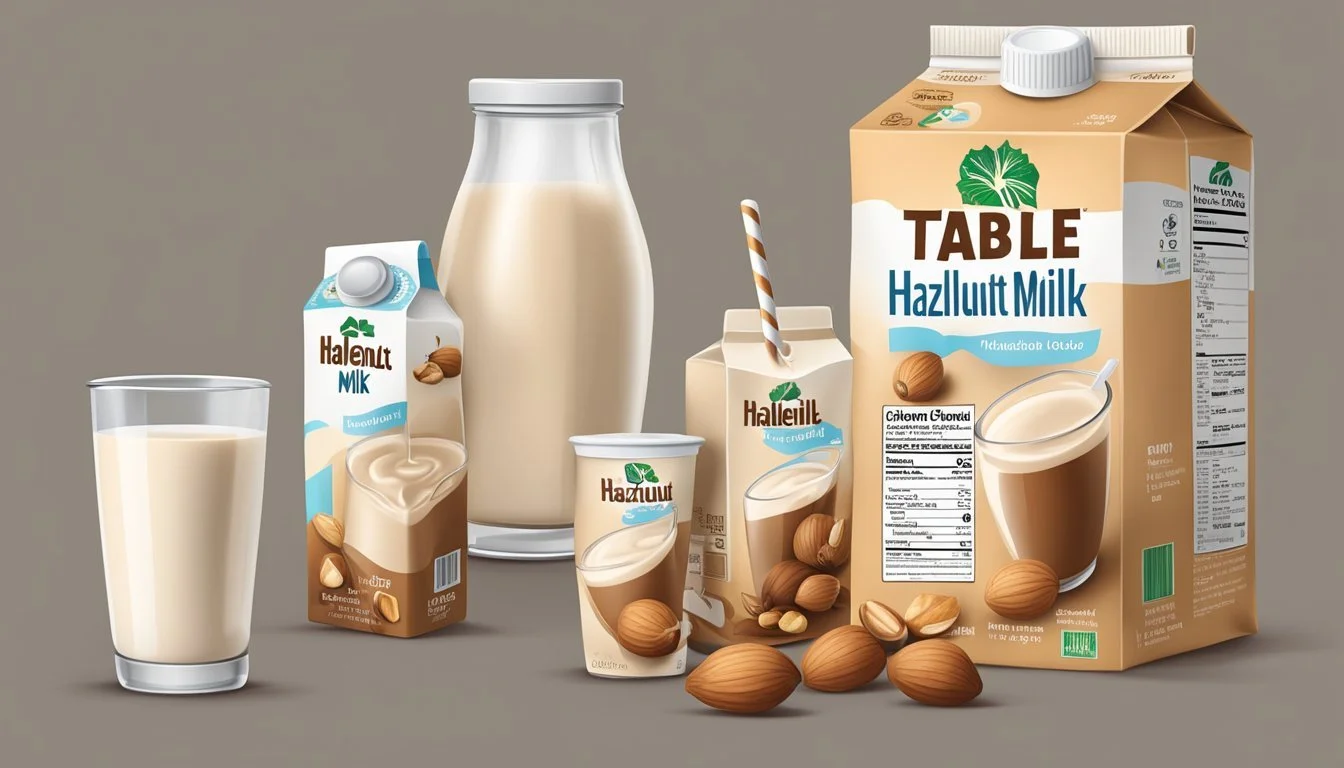How Many Servings of Hazelnut Milk Is Too Much
Understanding Limits
Hazelnut milk, a popular non-dairy alternative, has captivated many with its creamy texture and nutty flavor. As a plant-based milk, it caters to vegans and those with lactose intolerance alike, offering a nutritious beverage option. The health benefits are noteworthy, but it’s crucial to understand how much hazelnut milk is too much for optimal health.
Excessive consumption of any food or drink, even healthy ones, can lead to adverse effects. For hazelnut milk, moderation is key. A few servings a day can provide beneficial nutrients like vitamin E and healthy fats, but drinking much more than that could result in unnecessary calorie and sugar intake, especially if the milk is sweetened.
By balancing hazelnut milk intake within a varied diet, individuals can enjoy its benefits without overindulgence. Hazelnut milk can be an excellent addition to smoothies, cereals, and coffee, offering both a unique taste and nutritional advantages when consumed in appropriate amounts.
Nutritional Profile of Hazelnut Milk
Hazelnut milk offers several nutritional benefits, including a mix of vitamins, minerals, and macronutrients. This section will detail the specific vitamins, minerals, protein, fat, and carbohydrate content, some potential health benefits, and how hazelnut milk compares to other nut-based milks.
Vitamins and Minerals Content
Hazelnut milk contains various vitamins and minerals that contribute to its nutritional profile. It is often fortified with calcium, vitamin D, and vitamin B12 to enhance its nutritional value. Fortification ensures it serves as a suitable alternative to dairy milk.
Calcium is crucial for bone health, while vitamin D aids in calcium absorption and immune function. Vitamin B12 is essential for nerve function and DNA synthesis. Additionally, hazelnut milk naturally contains magnesium and potassium, which are important for muscle function and cardiovascular health.
Protein, Fat, and Carbohydrate Breakdown
In an 8oz serving, hazelnut milk has approximately 2 grams of protein, 9 grams of fat, and 1 gram of carbohydrates. While it is not particularly high in protein, it can still contribute to daily protein intake when combined with other sources.
The fat in hazelnut milk is primarily healthy unsaturated fat, including mono and polyunsaturated fats, which are beneficial for heart health. An 8oz serving contains about 0.3g of saturated fat, keeping it relatively low in unhealthy fats. Hazelnut milk also contains minimal carbohydrates and sugar, making it a low-carb option.
Comparison With Other Nut Milks
When compared to other nut milks like almond and cashew milk, hazelnut milk has a higher fat content. This can make it a richer and creamier option, suitable for those looking for a more flavorful experience.
Hazelnut milk typically has lower protein content than almond milk but similar carbohydrate levels. Fortified hazelnut milk can offer comparable levels of vitamins and calcium to other fortified nut milks.
Each type of nut milk has unique nutrient benefits, so the choice depends on individual nutritional needs and flavor preferences. Hazelnut milk stands out for its heart-healthy fats and potential antioxidant properties.
Recommended Serving Sizes
Determining the appropriate serving size of hazelnut milk is essential to maintain a balanced diet and ensure adequate nutrition. Here, we break down the USDA guidelines and explore the difference between servings and portions.
USDA Guidelines
The USDA recommends serving sizes that balance nutrition and calorie intake. For plant-based milks like hazelnut milk, a standard serving size is typically 1 cup (8 ounces). This portion aligns with general dietary guidelines.
For those incorporating hazelnut milk into their diet, consider its nutritional content. Hazelnut milk is often fortified with vitamins and minerals, providing essential nutrients such as calcium and vitamin D. Regular consumption should fit within daily dairy or milk alternative recommendations, usually around 2-3 servings per day.
Serving size helps manage calorie intake. A cup of hazelnut milk typically contains about 30-50 calories, depending on the brand and added ingredients. Monitoring these servings ensures dietary needs are met without excessive calorie intake.
Understanding Servings and Portions
Understanding the difference between servings and portions is crucial for dietary planning. A serving is a measured amount, like the USDA’s recommended 1 cup of hazelnut milk. A portion, however, may be more or less than a serving, depending on personal consumption.
When pouring hazelnut milk, use measuring tools to ensure accuracy. Overestimating portions can lead to higher calorie consumption than intended. Proper measure assists in maintaining a balanced diet.
Nutrition labels provide essential information on serving sizes and nutrient content. Pay attention to these labels to understand what constitutes a single serving and ensure proper dietary intake.
Maintaining the right balance of servings and portions helps in achieving nutritional goals, keeping calorie intake in check, and ensuring a healthy diet that includes hazelnut milk within recommended limits.
Health Benefits of Hazelnut Milk
Hazelnut milk offers a range of health benefits due to its nutrient-rich profile. It is particularly noted for its positive effects on cardiovascular health, weight management, and blood sugar control.
Cardiovascular Health
Hazelnut milk is rich in unsaturated fats, which are beneficial for heart health. Consuming these healthy fats helps improve cholesterol levels by reducing bad cholesterol (LDL) and increasing good cholesterol (HDL).
Antioxidants like vitamin E in hazelnut milk further protect the heart by preventing oxidative stress and inflammation.
Hazelnuts contain magnesium, which is crucial for maintaining normal heart rhythm and muscle function. The combination of these nutrients aids in reducing the risk of heart disease and promoting overall cardiovascular wellness.
Weight Management and Satiety
Hazelnut milk can support weight management efforts due to its fiber content, which promotes a feeling of fullness or satiety. This can help reduce overall caloric intake.
The protein content in hazelnut milk also contributes to satiety. A single serving can provide around 4 grams of protein, aiding in sustaining energy levels and reducing hunger between meals.
Despite its fat content, the fats in hazelnut milk are unsaturated, which are healthier and can be included in a balanced diet. This makes it a good option for those looking to manage their weight without sacrificing taste or nutrition.
Effects on Blood Sugar and Blood Pressure
Hazelnut milk has a low glycemic index, making it suitable for people with diabetes. It helps in moderating blood sugar levels, thanks to its balanced mix of fats, proteins, and fiber.
Hazelnut milk's magnesium content plays a role in regulating blood pressure. Magnesium helps to relax blood vessels, which can lower blood pressure and reduce the strain on the cardiovascular system.
Additionally, the antioxidant properties of hazelnut milk contribute to lowering inflammation and oxidative stress, which are factors in the development of hypertension and diabetes. These factors make hazelnut milk a beneficial option for maintaining stable blood sugar and blood pressure levels.
Risks and Considerations
Excessive consumption of hazelnut milk can lead to certain risks, especially for individuals with specific sensitivities or dietary restrictions. This section addresses the main concerns related to hazelnut allergies and other potential adverse effects from overconsumption.
Allergy Information
Hazelnut milk is derived from tree nuts, making it a potential allergen for those with nut allergies. Ingesting hazelnut milk can trigger allergic reactions ranging from mild symptoms such as itching and hives to severe responses like anaphylaxis. People with existing tree nut allergies should avoid hazelnut milk and consider alternative non-dairy options.
In addition, cross-reactivity may occur in individuals allergic to other tree nuts. Symptoms like inflammation, swelling, and digestive discomfort may arise. Always consult with a healthcare provider before introducing hazelnut milk into the diet if there are known nut allergies.
Possible Adverse Effects
Consuming large quantities of hazelnut milk might contribute to several health issues. Hazelnut milk contains calories, sodium, and sometimes added sugars, which can lead to weight gain if consumed in excess. Monitoring intake is crucial to maintaining a balanced diet.
Despite its healthy fats, excessive intake of hazelnut milk can increase saturated fat levels in the diet. High saturated fat intake is associated with higher cholesterol levels, posing a risk for cardiovascular diseases. Moreover, as with many nut-based products, hazelnut milk might lead to digestive discomfort for some individuals due to its fat content and potential fiber.
Pay attention to portion sizes and nutritional labels to avoid these adverse effects while enjoying the benefits of hazelnut milk.
Consumption Tips and Recipe Ideas
When incorporating hazelnut milk into your diet, there are numerous ways to enjoy its rich, nutty flavor. Below are practical uses in everyday culinary practices and some mouth-watering sweet and savory recipes to try.
Using Hazelnut Milk in Culinary Practices
Hazelnut milk serves as a versatile ingredient in both sweet and savory recipes. Use it as a dairy alternative in smoothies, coffee, and cereals. Its creamy texture blends well, enhancing the flavors of the dishes.
It can also replace dairy milk in baked goods such as cakes, muffins, and pancakes, offering a nuttier profile. For savory dishes, consider using hazelnut milk in soups and sauces to add a subtle nutty taste.
Sweet and Savory Recipe Suggestions
For a sweet treat, combine hazelnut milk with cocoa powder and a sweetener to make a rich hot chocolate. Add it to oatmeal with a drizzle of honey and fresh berries for a delectable breakfast.
In savory recipes, use hazelnut milk to make a creamy salad dressing by blending it with hazelnut oil, lemon juice, and herbs. Another idea is to create a nutty sauce for pasta by mixing hazelnut milk with nutritional yeast, garlic, and unsalted nuts.
Try using it as a base for soups, blending it with roasted vegetables for an added depth of flavor. Whether in sweet snacks or hearty meals, hazelnut milk can elevate the culinary experience.
Environmental and Ethical Considerations
Hazelnut farming and production have significant implications for the environment and ethical trade. Understanding these aspects is essential for consumers who prioritize sustainability and fair trade practices.
Hazelnut Farming and Sustainability
Hazelnut trees contribute positively to environmental sustainability. They help prevent soil erosion and support biodiversity by providing a habitat for various species.
Turkey, Italy, and the United States are major producers of hazelnuts, with Turkey leading global production. Sustainable farming practices, such as minimizing pesticide use and promoting organic farming, enhance the environmental benefits of hazelnut cultivation.
Turkey’s extensive hazelnut orchards face challenges such as climate change, which impacts yield and quality. Efforts to breed climate-resilient varieties and implement water-efficient irrigation systems are critical in maintaining the sustainability of hazelnut farming.
Trade and Industry Impact
The hazelnut industry influences global trade and local economies, particularly in regions like Turkey and Italy where it is a significant agricultural sector. Ethical concerns arise from labor practices in some producing countries.
Fair trade initiatives aim to improve working conditions and ensure fair wages for farmers. Certifications such as Fair Trade and Rainforest Alliance play a key role in promoting ethical practices in the hazelnut supply chain.
Consumers can support ethical trade by choosing products with these certifications. This helps ensure that their purchases contribute to sustainable and ethical agricultural practices.
Conclusion
Hazelnut milk offers several health benefits due to its rich nutrient profile.
It contains essential vitamins and minerals like vitamin E, magnesium, and B vitamins.
A serving of hazelnut milk typically provides 2 grams of protein and 9 grams of fat. This makes it a valuable addition to a balanced diet.
Moderation is key when consuming hazelnut milk.
Too much can contribute to excess caloric intake, potentially leading to weight gain.
A recommended daily serving size might vary, but generally, sticking to 1-2 servings per day is advisable.
Hazelnut milk can support heart health due to its healthy fat content. It also contains antioxidants which can help in disease prevention.
Including hazelnut milk as part of a varied diet can be beneficial for those seeking nutritious non-dairy alternatives.









